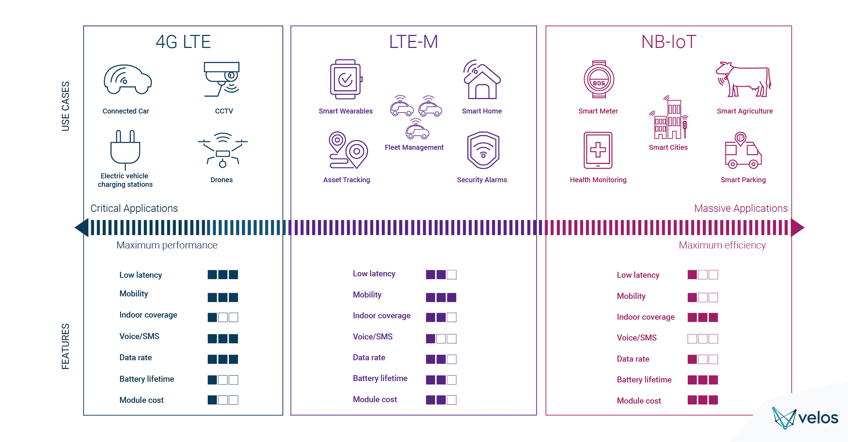

Massive IoT projects - Cat-M1 or NB-IoT?
Massive IoT deployment refers to a section of IoT where a high volume of IoT devices are deployed (hence the name) but none of these devices is very powerful on its own. IoT devices in a massive IoT system are usually simple, use a small amount of power, and don't need to be connected to the internet around the clock.
Massive IoT systems are generally used for tracking and monitoring purposes. These networks might be made up of devices like meters, sensors, and trackers. These devices usually only have one or two functions and are mainly used to gather data. Since all they typically need to do is gather and transfer data, they only connect to the internet periodically.
The challenge of these kinds of IoT systems is keeping maintenance to an absolute minimum. They should be extremely reliable, durable, and long-lasting.
Massive IoT connectivity
NB-IoT
There are two primary ways to keep these kinds of IoT projects connected, the first being NB-IoT (short for Narrowband IoT). NB-IoT uses low-frequency channels to keep devices connected to its network. These channels have previously gone unused because they are only able to transmit smaller amounts of data - not enough to support the needs of consumer-level devices.
When it comes to massive IoT, however, these channels are a great solution. IoT devices only need to send smaller amounts of data at periodic intervals. And since NB-IoT is relatively untapped, IoT projects that use NB-IoT don't have to share their network with non-IoT devices like smartphones.
Cat-M1
Cat-M1 is another IoT connectivity solution that works very well with massive IoT projects. Like NB-IoT, it transmits smaller amounts of data while consuming less power than traditional cellular networks. The big difference between the two, though, is that Cat-M1 uses existing LTE networks to keep IoT devices connected.
It works by using LTE infrastructure to send out waves at a lower frequency. This means that Cat-M1 connectivity can piggyback off of current LTE networks while still providing the benefits that IoT projects need.

How to choose the right connectivity for your IoT needs
While each of these connectivity solutions is capable of supporting a massive IoT project, there are some differences between the two that need to be kept in mind.
The first is complexity. NB-IoT is much, much simpler than Cat-M1, and while each only sends small amounts of data at a time, NB-IoT sends substantially smaller data packets.
The second is your technology needs. Because Cat-M1 is able to send higher volumes of data, it's typically a more costly service than NB-IoT. So Cat-M1 is generally only recommended if your IoT project needs its wider capabilities. Cat-M1 networks also work better with mobile IoT devices, while NB-IoT is better suited to stationary devices.
So, as a quick list, devices like meters and sensors will perform better on an NB-IoT network, while vehicles, trackers, and wearable devices are better suited to Cat-M1 networks.
Learn more by checking out our quick guide to connectivity here.
How LPWA connectivity will impact the future of IoT
Technically, it is possible to keep a massive IoT project connected through traditional cellular. However, IoT projects - particularly massive ones - have unique challenges and needs that traditional cellular can't meet very well. This includes things like scalability, reliability, and power consumption.
NB-IoT and Cat-M1 are able to meet these needs in a cost-effective way, keeping massive IoT projects agile and sustainable. As these technologies become more widespread and accessible to IoT projects, it will be easier and simpler for IoT systems to be deployed around the world.
IoT connectivity gives IoT businesses the ability to choose the connectivity solution best suited to their business's needs without having to make sacrifices in other areas, like device lifespan or data consumption.
How Velos IoT can keep your IoT deployment connected
At Velos, we offer Connect LPWA Solution with both NB-IoT and LTE-M connectivity.

Connect your devices to LPWAN with a Velos IoT SIM
- Connect to CAT-M1 on 77 networks in 40 countries and NB-IoT(NB1) on 47 networks in 34 countries and fallback in areas with no LPWAN
- LPWAN enhanced features – PSM, eDRX available for selected networks
- Available in various SIM form factors, including MFF2, 2FF, 3FF, 4FF and eUICC.
- Available in different grades, including standard plastic, robust plastic and Industrial (Embedded SIM)
- Dynamic and fixed private IP allocation available
Check out our Connect LPWA solution here.
Conclusion
Keeping an IoT project connected can be a challenge, but it doesn't have to be! With new connectivity solutions being innovated specifically for the IoT industry, you can find the option that works best for your project's needs.
 To learn more about IoT deployment on a global scale, download our white paper, where the Velos IoT team offers insights on how to prepare for IoT at scale.
To learn more about IoT deployment on a global scale, download our white paper, where the Velos IoT team offers insights on how to prepare for IoT at scale.
Speak to a Velos IoT expert
Related articles


What are PSM and eDRX features in LTE-M and NB-IoT?
One of the main challenges of IoT is keeping deployed devices powered. Traditional cellular...

Is Narrowband IoT The Next Big Thing?
The Internet of Things (IoT) technologies are revolutionising businesses and our personal lives in...

